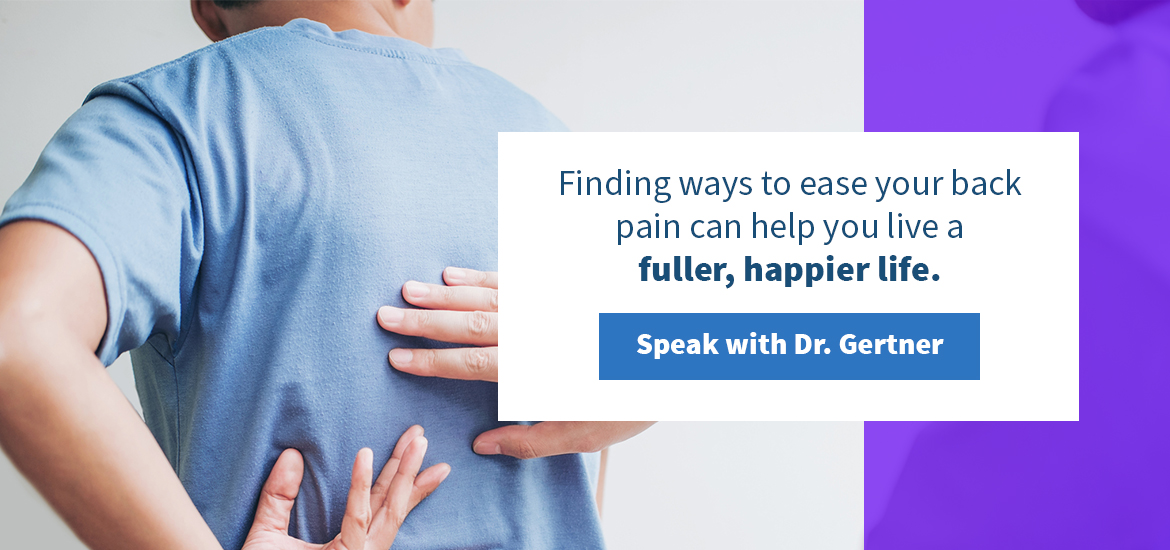If you experience chronic back pain, you know how much of a burden it can be. Once you’ve identified the source of your chronic back pain, you can use several strategies for back pain relief, including certain lifestyle adjustments and treatment methods. Learn about common causes of back pain and steps you can take to reduce your pain.
What Are the Common Causes of Chronic Back Pain?
First, it’s essential to understand why you’re dealing with chronic back pain. It can stem from many different causes and several factors may contribute to the problem. Some common causes of chronic back pain include:
- Poor posture: Sitting with poor posture each day can lead to chronic back pain.
- Injuries: An injury can cause exertion or strain on the back.
- Mental health: Specific mental health conditions, such as depression or anxiety, can cause or worsen back pain.
- Osteoporosis: Spinal bones weakened by osteoporosis can contribute to pain, as well.
A wide range of other conditions can cause or contribute to back pain, so it’s important to meet with a health care professional if you’re struggling with chronic back pain. This expert will determine the pain’s origin and offer strategies for pain relief.
8 Tips to Help You Cope With Chronic Back Pain
After discussing the cause of your back pain with your health care professional, you might try several methods to alleviate your pain. Try these eight tips for back pain relief.
1. Try Deep Breathing Meditation
Doing meditation exercises allows your body to relax, relieving tension to alleviate your chronic pain. These exercises also encourage healthy stress management — stress tends to amplify chronic pain. You can find plenty of videos, smartphone apps and other resources to guide you through meditation. Even if you just practice deep breathing every so often, you may feel less stressed or anxious as a result.
2. Address Sources of Stress
Since stress can worsen back pain, recognizing and addressing your stress at its source can be beneficial. Notice the events in your daily life that cause stress, and find ways to eliminate those sources. For instance, if rushing around to get ready in the morning is a source of stress for you, consider setting your alarm a few minutes earlier.
3. Engage in Regular Exercise
Regular exercise is one of the most important things you can do to alleviate back pain. Strengthening your core improves your posture, prevents injuries and assists in injury recovery — physical activity will help you rebuild strength and ease back pain. In addition, exercise releases chemicals called endorphins, which boost your mood and inhibit your pain perception. Before you come up with a workout routine, speak with your doctor about which exercises will be safe for you.
4. Find Ways to Get Better Sleep
Often, chronic pain and insomnia go hand-in-hand. Getting enough sleep can help reduce your pain sensitivity, so it’s vital to find ways to improve your sleep. For example, exercising during the day can lead to better sleep. Additionally, limiting how much alcohol you drink can help you sleep better. Excess drinking can lead to restless sleep and render sleep less restorative. If you want to reduce your back pain, you may want to drink less alcohol.
5. Eat a Healthy, Balanced Diet
Diet has a significant influence on your overall well-being. Make sure your meals contain plenty of vitamins and minerals without too much sodium or fat. Incorporate more fruits, vegetables and lean meats and try to cut back on pre-packaged or fast food. If you’re unsure how to make healthier meals for yourself, ask your primary doctor or a nutritionist for advice.
6. Keep a Detailed Journal
You may find it helpful to keep a daily journal. This way, you’ll be able to find connections between your lifestyle and your pain levels. For example, if you do yoga on one day, you may notice a difference in your pain compared to when you didn’t exercise on a previous day. Each day, set aside a few moments to record:
- Your current pain level
- Exercise or activities you’ve done
- How much you’ve slept
- What you’ve eaten
- Your emotional or mental state
If needed, you may want to show your findings to your health care professional.
7. Talk About It
You may feel it’s beneficial to talk about your chronic pain with a mental health professional or others who experience similar problems. Often, chronic pain corresponds with mental health concerns, so seeking counseling may be a good idea. You could also find a support group for people who experience chronic pain. These individuals can provide essential emotional help as you navigate your chronic pain.
8. See a NUCCA Chiropractor
One effective chronic back pain treatment is National Upper Cervical Chiropractic Association (NUCCA) chiropractic care. This specialized form of care alleviates pressure from the nervous system by restoring the skull, spine and pelvis to their proper alignment. NUCCA is safe, non-invasive and painless.
After evaluating x-rays, the doctor identifies sources of misalignment. They’ll then perform subtle and gentle realignments. You’ll only feel slight pressure — no twisting or popping — as the process helps to alleviate your chronic back pain. Through x-rays, you’ll be able to see the correction in real-time. Since it addresses back pain at its source, NUCCA chiropractic care is a long-term and reliable solution.
Contact Dr. Gertner for Back Pain Support in the New York Area
Finding ways to ease your back pain can help you live a fuller, happier life. First, you’ll need to meet with your doctor to verify the source of your pain — many underlying medical conditions can lead to chronic back pain. Once you’ve identified the cause, you can start making simple lifestyle changes to relieve your back pain. Your diet, exercise, sleep patterns and mental state all impact your experience of chronic pain. In addition to making lifestyle changes, you might want to seek NUCCA chiropractic treatment.
If you’re looking for an effective, painless and non-invasive back pain treatment, consider NUCCA chiropractic treatment. Only about 200 doctors in the world are able to perform NUCCA spinal correction, including Dr. George Gertner of Upper Cervical Chiropractic. At your appointment, Dr. Gertner will first discuss your goals with you. He’ll then perform a complete chiropractic wellness exam, record a series of x-rays and share his findings with you. At that point, he’ll be able to perform any necessary realignments, beginning the process of alleviating your pain.
REVIEWED BY DR. GEORGE GERTNER

Dr. George Gertner is a family man, healer, philanthropist, author of “The Gift of Hope”, public speaker, and founder of one of the world’s busiest Upper Cervical Chiropractic clinics.
After receiving his bachelors degree in biology from Hofstra University in Hempstead, NY Dr. Gertner moved to Atlanta, GA to attend Life University. Before graduation, Dr. Gertner had a severe injury to his lower back. Traditional chiropractic procedures were not providing relief until he met a chiropractor that specialized in NUCCA (National Upper Cervical Chiropractic Association.)
Then he spent the next two years mentoring from one of the best Upper Cervical doctors; learning in the same office that helped change his life. After two years, Dr. Gertner returned home to New York to open his own office. He currently is one of less than 300 NUCCA chiropractors worldwide.
Dr. Gertner has been featured numerous times in Chiropractic Monthly Magazine for his expertise in treating Trigeminal Neuralgia and Myofascial Pain. Dr. Gertner has lectured locally and nationwide discussing various symptoms using the Upper Cervical technique.




